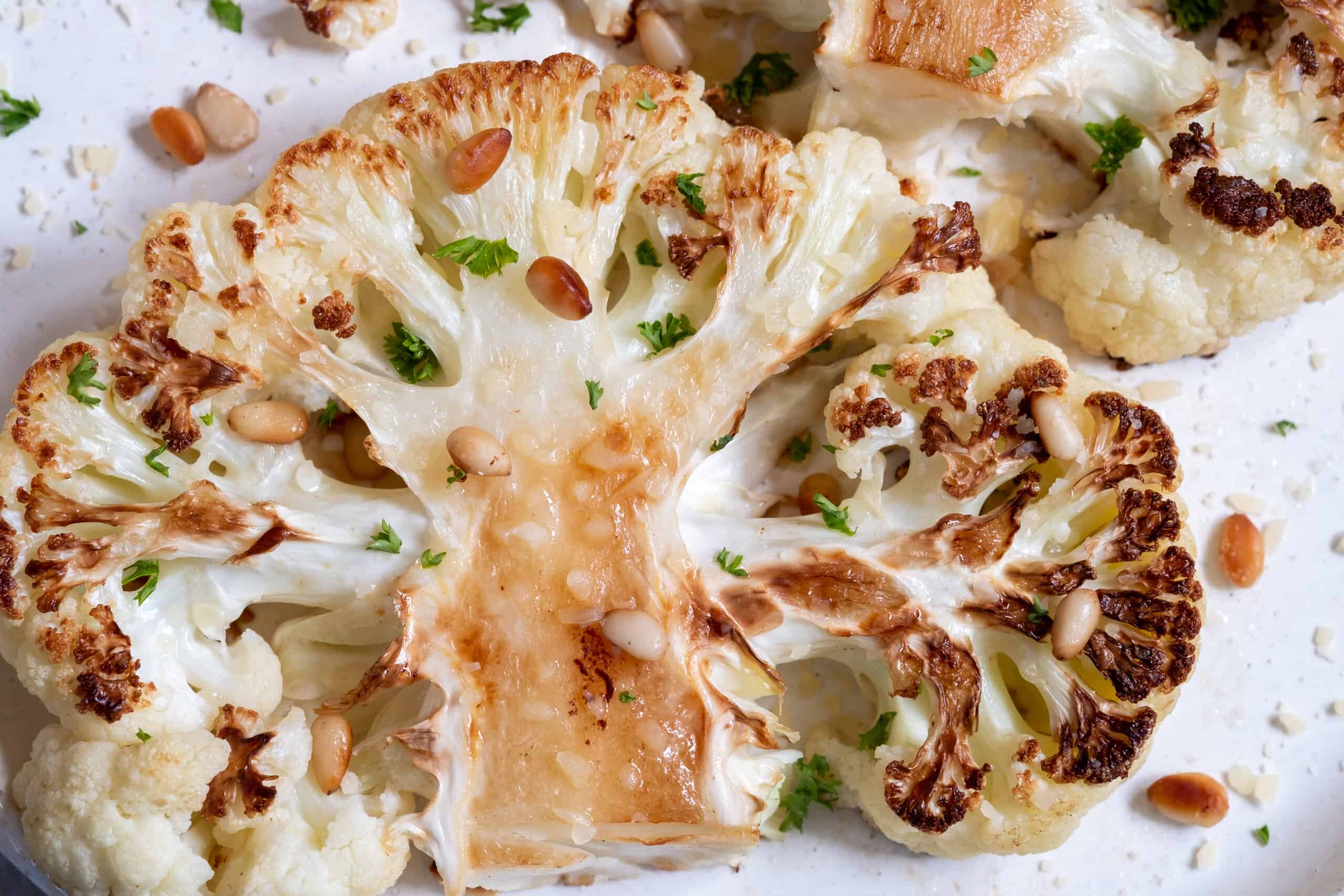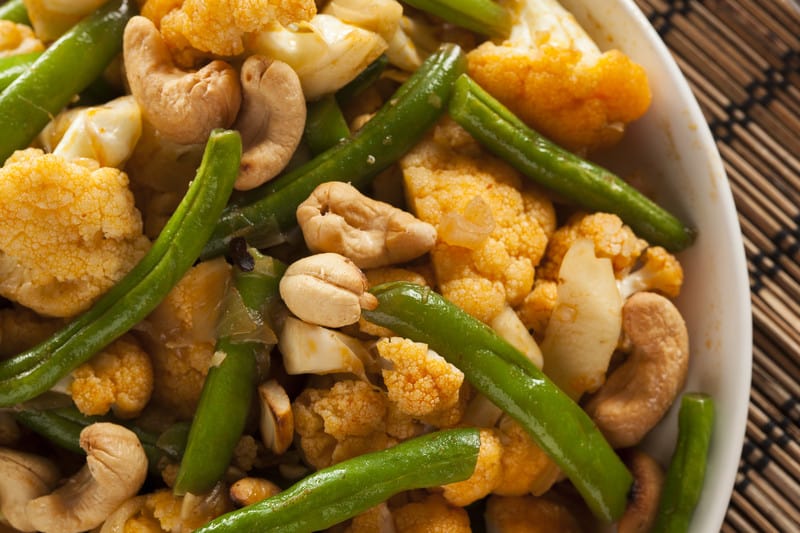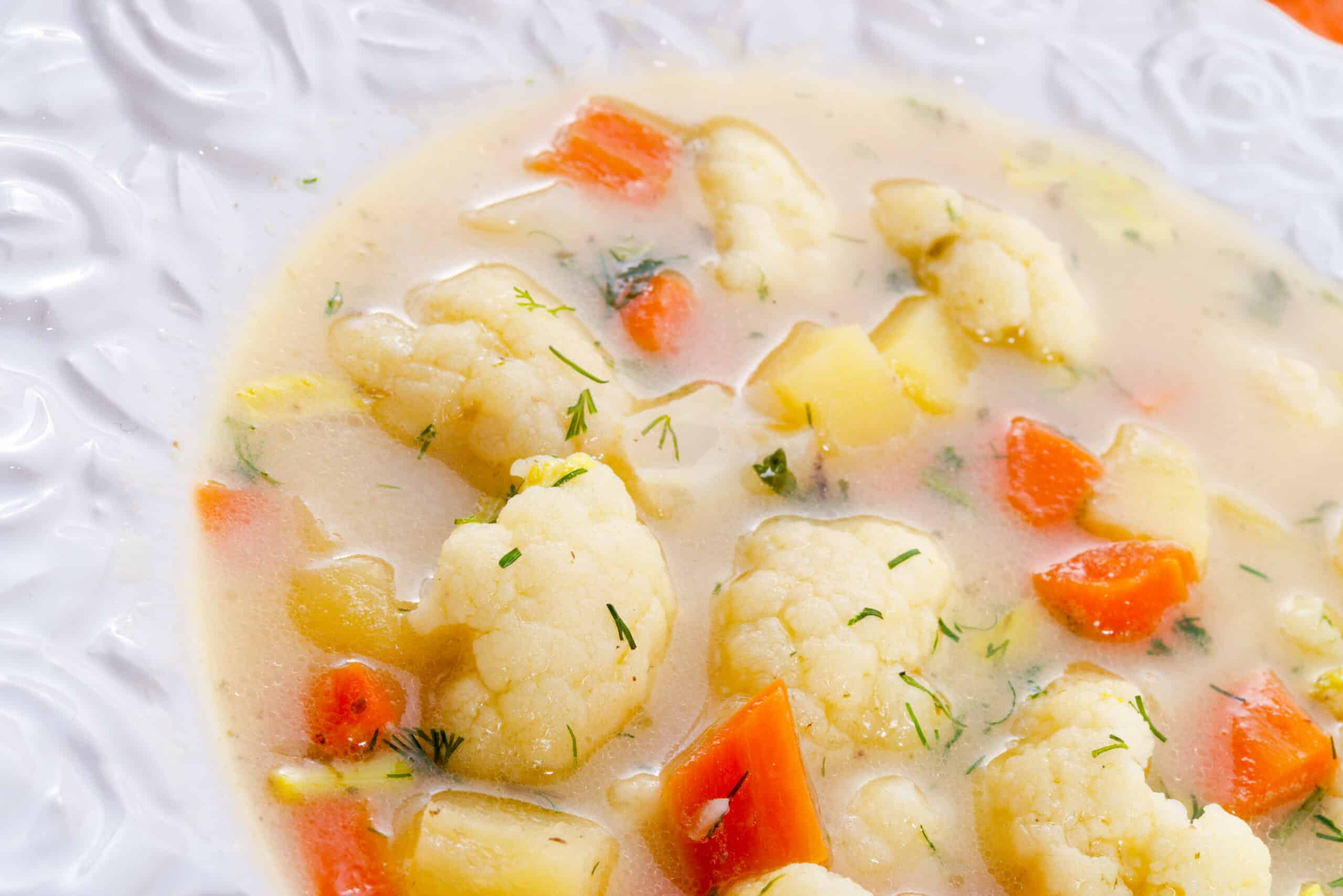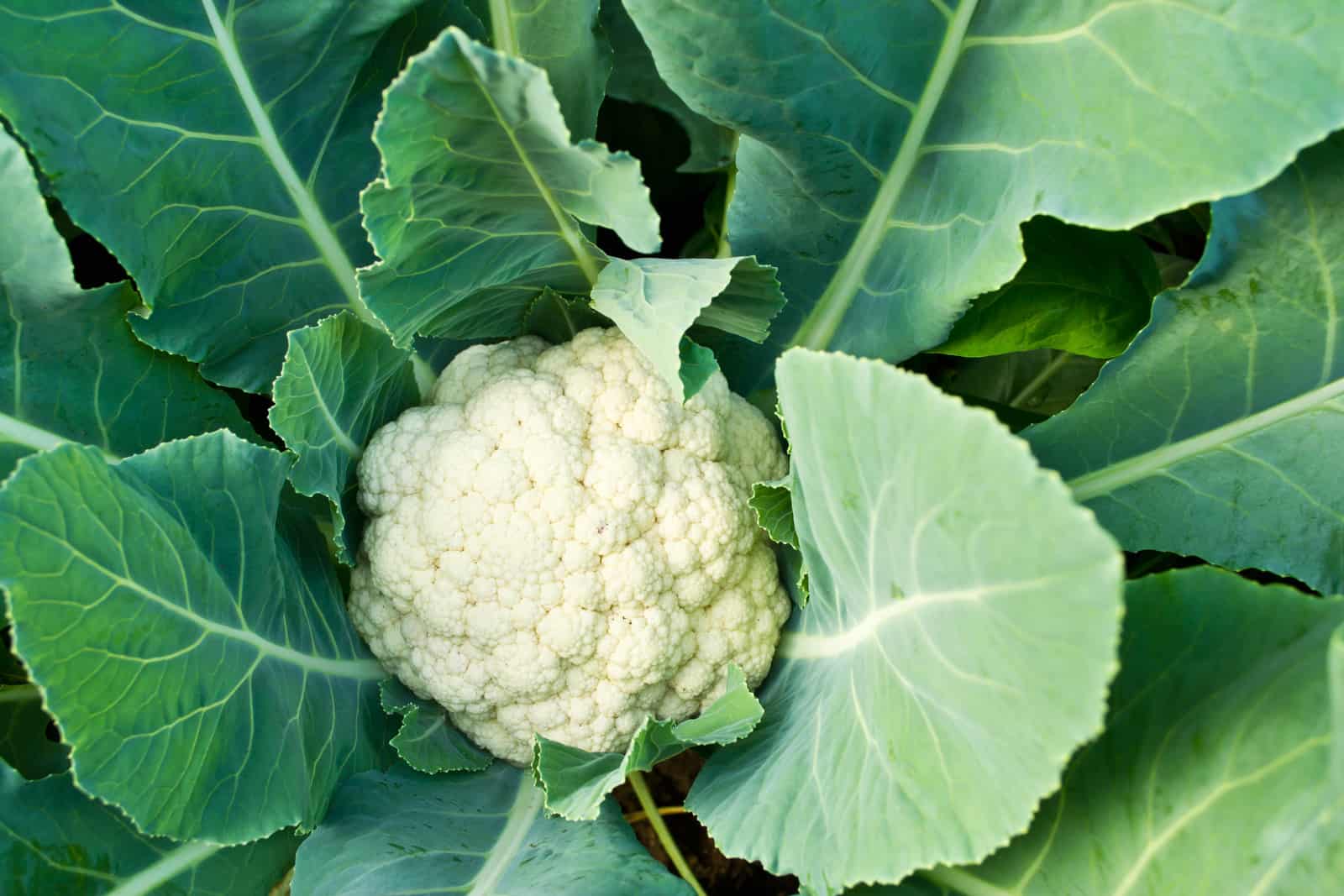The perfect thing about cauliflower is that the size of the head is no indicator of quality. Big heads or small snack-sized heads–as long as they are fresh–will be equally tasty.
Cauliflower is best harvested in late spring or fall when temperatures are moderate to cool.
Fresh cauliflower should taste mildly sweet or nutty and have a delicate crumbly crunch. Raw cauliflower should not be chewy or squeaky when you bite into it. As for cooking, if the cauliflower you are eating tastes “strong” or has a cabbagey smell then it probably is not fresh or has been cooked too long.

When selecting cauliflower, look for heads that are creamy white. The curds or florets of fresh cauliflower should be compact and tight. One way to test for freshness is to snap the leaves that surround the head at their midribs. If there is a “snap”, the head is fresh. Avoid heads that are discolored or spotted. If the stem of a cauliflower head is dry or discolored, the head is not fresh.
Three flowerets of raw cauliflower (about 2 oz) contain 14 calories, 12 calories cooked.
How to choose cauliflower
- Select heads of cauliflower that are firm, compact, and creamy white.
- Bright green leaves indicate that the head is fresh.
- Avoid cauliflower with florets that are dull or spotted or with yellow, wilted leaves.
How to store cauliflower
- Unwashed cauliflower will keep in a perforated bag in the refrigerator for 10 days.
- Cooked cauliflower will keep for just 2 or 3 days.
- Cauliflower will keep in the freezer for up to 4 months if you first blanch it for 3 minutes in boiling water.
- Cauliflower can be pickled in vinegar and brine and canned for up to 1 year.
How to prep cauliflower for cooking
- Before cooking cauliflower, remove the tough lower stalk just below the head then slice the curd into pieces of similar size for even cooking.
- Do not cook cauliflower in aluminum or iron pots; a chemical reaction will turn the cauliflower yellow, brown or blue-green.
How to steam cauliflower
- Break the cauliflower into bite-size pieces. (A whole head may take as long as 30 minutes to simmer.)
- Add a few inches of water to a pot then insert a steamer basket. The water should not touch the bottom of the steamer basket.
- Lightly salt the water and season the florets with salt and pepper.
- Cover the pot and bring the water to a simmer over medium-high heat.
- Steam until the tip of a paring knife can be inserted easily into the florets, about 8 to 10 minutes depending on the size of the florets. Remove the lid frequently to release cooking gases.
- Serve the florets just crisp, al dente. Overcooked florets will be mushy.
Serving steamed cauliflower
- Steamed cauliflower florets can be mashed with a potato masher and served like mashed potatoes
- Florets can be served with lemon juice, olive oil, browned butter, chopped nuts, or grated hard cheese.
- Steaming is the surest way to retain the delicate flavor of cauliflower.
How to sauté cauliflower
- Break the head of cauliflower into small bite-size pieces.
- Place a small amount of olive oil in a large skillet (avoid crowding, which leads to steaming).
- Sizzle florets quickly. Again, do not overcrowd the skillet, work in batches, if necessary.
- Add aromatics soften in the oil; aromatics might include thinly sliced onion, smashed garlic, or herbs.
- Cook until the florets are nicely browned and have a firm, yet tender texture.
- Serve at room temperature.
Serving sautéed cauliflower
- Serve sautéed cauliflower with yogurt or chopped almonds or vinegar.

How to roast cauliflower
- Break the head of cauliflower into small bite-size pieces or slice it into ½-inch-thick sections.
- Preheat the oven to 450 degrees F.
- In a large mixing bowl, drizzle the florets with olive oil and season with salt and pepper.
- Arrange the florets in one layer on an ungreased baking sheet or large ovenproof skillet.
- Add spices or aromatics such as a pinch of ground turmeric, whole cumin or fennel seed, crushed cloves of garlic, spices, chiles, or red-pepper flakes.
- Cook until browned and caramelized about 20 to 30 minutes.
- Optional: sprinkle with a dusting of Parmesan about 10 minutes before being cooked.

How to stir-fry cauliflower
- Use a wok that’s cast iron, stainless steel, or rolled carbon steel.
- Heat a wok over high heat for several minutes.
- Add oil, preferably canola, peanut, or another oil with a high smoke point.
How to fry cauliflower
- Fill a medium pot about halfway with neutral oil and heat to 375 degrees F.
- Fry florets in batches. Drop florets into the hot oil and fry until deeply golden brown, 3 to 5 minutes.
- Remove with a slotted spoon and let drain on a paper towel-lined plate. Season with salt.
Frying option: Pan-fry or deep-fat-fry cauliflower in a wet batter until the crust is golden brown.
How to boil cauliflower
- Do not cook cauliflower in aluminum or iron pots; a chemical reaction will turn the cauliflower yellow, brown or blue-green.
- To prevent cauliflower from discoloring during cooking, add a tablespoon of lemon juice or one cup of milk to the cooking water.
- To absorb cooking odors, add a piece of bread to the water when boiling cauliflower.

How to purée cauliflower for sauce or soup
- Simmer florets in chicken or vegetable stock or milk until the florets are very tender.
- Transfer the florets to a blender with a slotted spoon, along with enough of the cooking liquid to start the blending. (Less liquid with give a thick purée for serving beneath roasted chicken; more will give you a silky soup that can be topped with croutons and chopped herbs.
How to serve cauliflower
- Serve cauliflower raw or cooked. Cauliflower can be boiled, sautéed, steamed, or stir-fried. It is always best tender crunchy and not overcooked.
- Cauliflower can be prepared like broccoli and the two are interchangeable in recipes.
- Serve raw cauliflower alone or with a dip. Raw florets can be used as an appetizer and in salads.
- Serve cooked cauliflower as a vegetable side dish or add it to soups, stews, pasta, omelets, soufflés, or quiches.
- Raw or steamed until tender-crisp and then chilled, florets of cauliflower can be dipped in guacamole, curried mayonnaise, or Russian dressing.
- You can marinade raw or parboiled florets in a vinaigrette dressing and then mix them with broccoli, pimiento, mushrooms, and onions.
- Steamed or boiled cauliflower can be buttered or dressed with a white or cheese sauce.
- Serve cooked cauliflower alone or mixed with broccoli, green peas, mushrooms, tomatoes, carrots, onions, celery, or a combination of these.
- Cooked cauliflower can be puréed and added to soufflés and soups.
- Top cooked cauliflower with Mornay or hollandaise sauce or with béchamel sauce and grantinéed.
- Cook cauliflower leaves with other mixed greens.
- Season cauliflower with salt, pepper, onion, garlic, dill, tarragon, nutmeg, mace, paprika, allspice, cinnamon, mustard, oregano, caraway seed, celery seed, curry powder, cumin, coriander, rosemary, or thyme.
- You can top raw or cooked cauliflower with plain or flavored butter or margarine, vinaigrette dressing, plain or flavored mayonnaise, cheese sauce, melted yellow, egg yolk or butter sauces, tomato sauce, or white sauce.
How to serve cauliflower raw
- Cauliflower can be broken into bite-size pieces and served on a crudité platter.
- Serve with a dip or salt and pepper.
How to make cauliflower soup
- To prepare a rich cauliflower soup, cook the florets in lemon or tarragon-flavored chicken broth until tender, purée the florets in a blender with a little milk, and stir in cream. Serve this soup hot sprinkled with nutmeg or cold with lemon slices or shredded carrot.
Cauliflower flavor partners
Cauliflower has a flavor affinity for anchovy, butter, chervil, chives, cream, curry, garlic, ginger, Gruyére cheese, lemon, mustard seeds, olives, Parmesan cheese, thyme, and turmeric.
Cauliflower nutrition
- Cauliflower contains vitamin C, folic acid, potassium, and iron.
- A cupful of cauliflower flowerets contains 27 calories.
A royal passion for cauliflower
Many French kings went by the name Louis. The name means famous warrior. The moniker worked for many of the kings of France, but by the time the name came down to Louis XV, the French had just about had it with the idea of an absolute monarchy.
While Louis XV did little to popularize the notion of the divine right of kings, he was a great lover of cauliflower and is perhaps rightfully credited with bringing that heavily flowered vegetable cousin of the cabbage to its culinary high point in history.
Even today if you see the name “Du Barry” on a French menu—such as crème Du Barry—you can be assured that cauliflower figures into the recipe. (Countess Du Barry was Louis’ favorite mistress and she shared her love for everything cauliflower with the king and his court.)
The royal passion for cauliflower may be history, but it can truly be said that cauliflower is one of those vegetables that can do it all. Cauliflower florets—sometimes called “the curd”–can be eaten raw, baked, boiled, steamed, roasted, french-fried and stir-fried. They can also be sautéed and pureed after cooking.
Get to know cauliflower
- Cauliflower is a single-stalked, fleshy-stemmed plant with compact curd-shaped flower heads surrounded by large green leaves. A cauliflower plant can grow from 18 to 24 inches (45-61 cm) tall.
- Cauliflower is a member of the cabbage family and a close cousin of broccoli. There are white, green, and purple-headed varieties of cauliflower. White-curd cauliflower has a mild cabbage-like flavor. The green and purple varieties are milder yet.
- Purple-headed cauliflower is sometimes called Purple Cape broccoli.
- Romanesca cauliflower–also called Romanesco–is a warm-weather or late-summer cauliflower with an unusual look. Romanesco has a tight, compact head of florets like a common cauliflower but is lime green and shaped like an upside-down cone. It can be cooked just like a common cauliflower.
- Broccoflower is a hybrid cross between broccoli and cauliflower with a light green cauliflower head and a mild taste. It too can be prepared just like regular cauliflower.
- Cauliflower originated at the eastern end of the Mediterranean and has been in cultivation since the sixth century B.C.
- The Moors introduced cauliflower to Spain in the twelfth century. From Spain, cauliflower was introduced into Italy in the late fifteenth century and into France in the mid-sixteenth century.
- The name cauliflower comes from the Latin words caulis which means “stalk” and floris which means “flower.”
- The botanical name for cauliflower is Brassica oleracea var. botrytis.
Cauliflower articles at Harvest to Table:
How to Plant and Grow Cauliflower
Cauliflower Seed Starting Tips
How to Harvest and Store Cauliflower
Cauliflower Growing Problem: Troubleshooting
Seven Easy Ways to Serve Cauliflower
Articles of interest:
Best Herbs for Container Growing
Garden Planning Books at Amazon:
- Vegetable Garden Almanac & Planner
- Kitchen Garden Grower’s Guide Vegetable Encyclopedia
- Vegetable Garden Grower’s Guide
- Tomato Grower’s Answer Book
More kitchen tips:
Bring your harvest to the table. Kitchen prep tips and easy recipes for the vegetables you grow. Click below for vegetable prep and recipes you can use now.
- Almonds
- Apples
- Apricot
- Aprium
- Artichoke
- Arugula
- Asparagus
- Avocado
- Bamboo Shoots
- Banana
- Basil
- Beans, Dried
- Beans. Long
- Beans, Shell
- Beans, Snap
- Beets
- Bitter Melon
- Blackberry
- Bok Choy
- Broccoli
- Broccoli Raab
- Brussels Sprouts
- Cabbage
- Cardoon
- Carrots
- Cauliflower
- Celeriac
- Celery
- Chard
- Chayote Squash
- Cherimoya
- Cherries
- Chestnut
- Chickpea
- Chinese Cabbage
- Chives
- Cilantro
- Citron
- Clementine
- Collards
- Coriander
- Corn, Sweet
- Corn, Baby
- Corn Salad, Mache
- Cranberry
- Cress
- Cucumber
- Daikon
- Dandelion
- Dill
- Eggplant
- Endive, Belgian
- Endive and Escarole
- Fava Beans
- Fig
- Florence Fennel
- Garlic
- Ginger
- Grapefruit
- Grapes
- Guava
- Horseradish
- Jerusalem Artichoke
- Jicama
- Jujube
- Kale
- Kiwifruit
- Kohlrabi
- Kumquat
- Leeks
- Lemongrass
- Lemons
- Lettuce
- Lime
- Mache (Corn Salad)
- Mandarin Orange
- Mango
- Maple Syrup
- Marjoram
- Melons
- Michihili
- Mint
- Mizuna
- Mushrooms
- Mushrooms, Cremini
- Mustard Greens
- Napa Cabbage
- Nectarine
- Okra
- Olives
- Olive oil
- Onions
- Oranges
- Oregano
- Parsley
- Parsley Root
- Parsnips
- Passion Fruit
- Pawpaw
- Peaches
- Pears
- Peas, Garden Snap
- Peas, Snow
- Pei Tsai
- Peppers, Chili
- Peppers, Sweet
- Persimmon
- Pineapple
- Pineapple Guava
- Plantain
- Plums
- Pluots
- Pomegranate
- Potatoes
- Prickly Pear
- Pumpkin
- Quince
- Radicchio
- Radishes
- Raspberries
- Rosemary
- Rhubarb
- Rutabaga
- Sage
- Salsify
- Sauerkraut
- Savory
- Shallots
- Sorrel
- Spinach
- Squash, Summer
- Squash, Winter
- Strawberries
- Sunchokes
- Sunflower
- Sweet Potato
- Swiss Chard
- Tangerine
- Taro
- Tarragon
- Thyme
- Tomatillo
- Tomato
- Turnip
- Turnip Greens
- Yams





